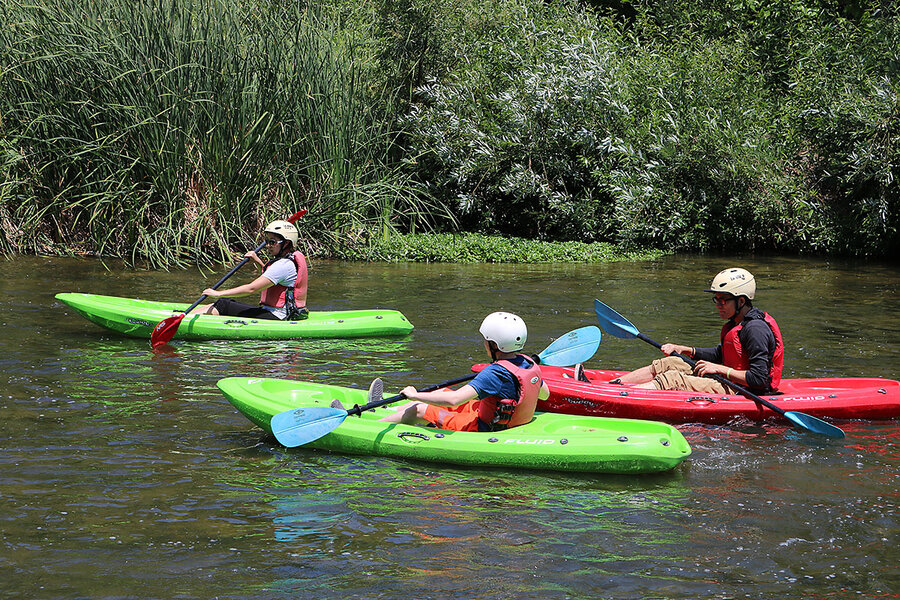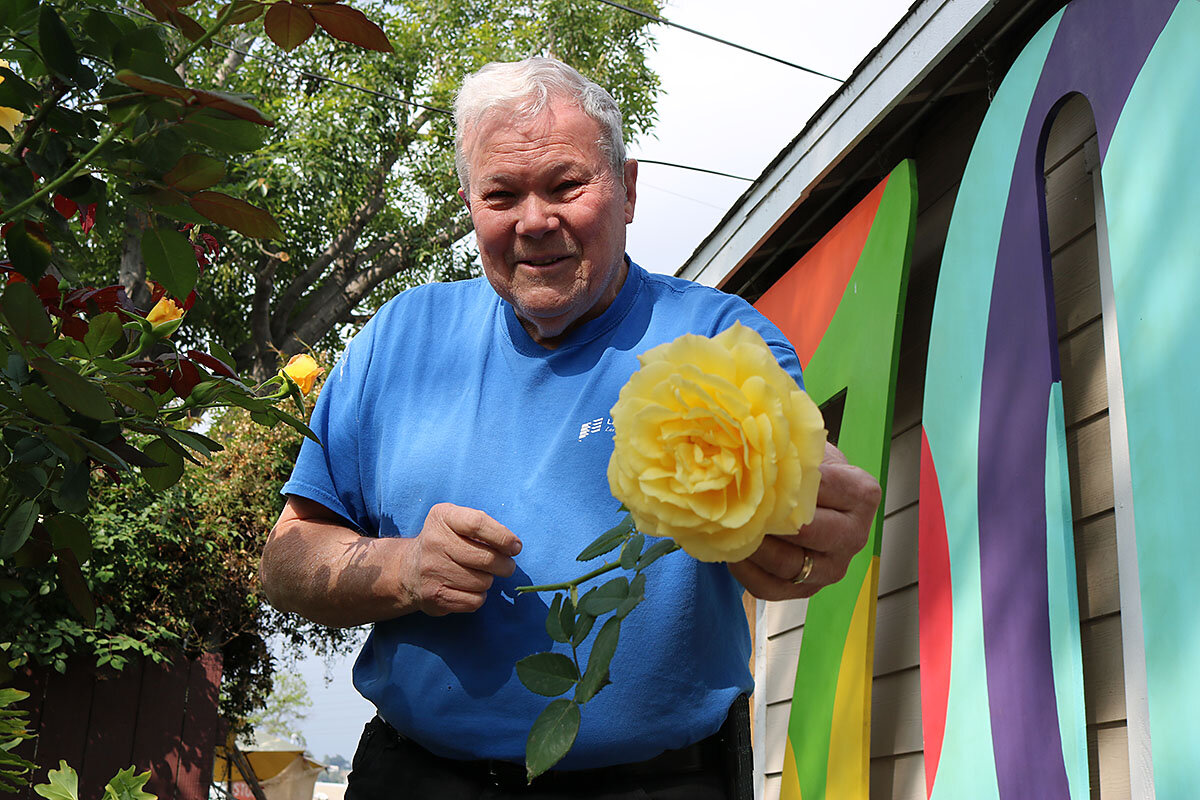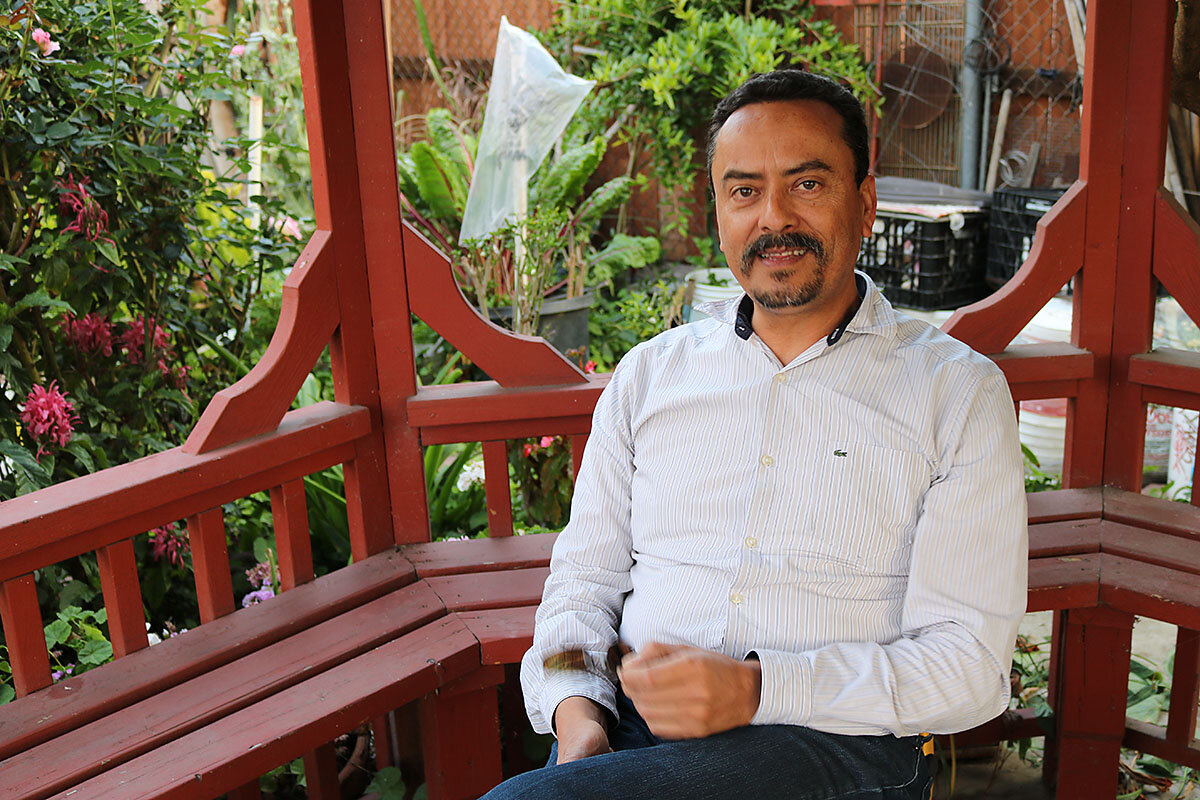A journey along the shoals of a gentrifying L.A. neighborhood
Loading...
| Los Angeles
The kayak refused to obey.
I had done everything as instructed: I’d measured my grip on the paddle by holding it above my head with my arms at 90-degree angles. I’d swept the blade in a wide arc across the water to turn the kayak. And I’d used my torso, along with my arms, to add power to the stroke.
Still, the little red boat hurtled towards the jumble of rocks downstream.
Why We Wrote This
The influx of new money into a struggling neighborhood, while welcome, can also spark resentment. In L.A.’s Frogtown, our reporter got a river’s-eye view of a community determined not to lose its history or values.
Not that such insubordination surprised me. Kayaking, along with anything that resembles sport, does not number among my strengths. But I’d had the idea that reporting about Los Angeles – in particular, the swiftly gentrifying riverside neighborhood of Frogtown – from the rapids of the L.A. River would be a fine way to close out my two-year stint as the Monitor’s West Coast correspondent.
Thus I spent Memorial Day in a bright crimson kayak, scraping myself off of watery impediments (often rocks, more often other people’s boats) about once every five minutes, for the entire hour-and-a-half expedition.
This fitful creep downriver was every bit as aggravating as you might imagine, but it did have one benefit: It gave me time to think about my story.
The tale of Frogtown is, on the surface, a familiar drama of longtime residents watching as developers descend upon their “undiscovered” neighborhood. Abandoned buildings become renovated loft spaces, old warehouses are reborn as breweries, street corners breed hipster cafés – and the locals are slowly priced out.
Dig a little deeper, though, and what you find is a community that has, for most of its history, held fast to its local character while enduring the convulsions of growing cosmopolitanism. It’s a place that daily navigates between the values of hometown pride and family loyalty, and that sweeping California spirit of opportunity, innovation, and reinvention.
Winding through the narrative is the L.A. River. The waterway features prominently in Frogtown’s history and is the focal point for present and future plans. As I paddled down this remarkable city artery, watching waterfowl perch on rocks and fish flit in and out of the water, I could understand why.
“We knew there was something special down here,” says Steve Appleton, who runs L.A. River Kayak Safari, the tour group I was with. “The river is this great receptacle for people’s desires. They want it to be this and that. I’m one of those people that took it on as something that receives my hopes and desires for the city. It’s a historic location of Los Angeles.”
Frogs as thick as locusts
A few days before Memorial Day, I met with Bob Berg, who has lived off and on in Frogtown for 74 years. He is one of the neighborhood’s longest-standing residents. We sat in the dining room of the one-bedroom bungalow on Newell Street that he shares with his wife, Janet. The house faces Mr. Berg’s childhood home.
The retired police officer still remembers trekking across the river – no one called it the L.A. River back then – on the way to Irving Junior High School, just off Fletcher Road. “We went right across the river, just walked across ... even if it was up to our knees,” he recalls.
Frogs (or toads) populated the area in the thousands, and kids would make a game of taking mason jars down to the banks to collect tadpoles. Some say the neighborhood, whose official name is Elysian Valley, came to be called Frogtown because the amphibians would emerge from the river “so thick it was like locusts,” Berg says. “You could not walk without stepping on them. They just blanketed the entire neighborhood.”
The Frogtown of Berg’s childhood is one of “Leave It to Beaver” wholesomeness, where everybody knew everybody and kids could play in the streets without fear. That began to change in the 1960s, after the completed I-5 sundered the neighborhood from bordering communities and swallowed the small businesses that had lined Riverside Drive. Immigrant families, mostly Mexican Americans, began settling in Frogtown, setting off a period of white flight to the suburbs.
As the neighborhood changed, so did residents’ relationship with the river. Gabriel Gapol, who moved to Frogtown with his mom and brother when he was 6, still remembers swimming with tadpoles as child. By the time he was a teenager, much of the riverbank was gang territory, claimed by Mr. Gapol’s own Frogtown gang. “There used to be overgrown bushes there. We used to turn those into hideaways,” says Gapol, who will be 60 this year, in a phone interview from Tacoma, Wash. “That was like our safe haven, the L.A. River. Rival gang members knew that was our territory.”
With the gangs came violence. Shootings became commonplace – Gapol, who now works closely with a Christian ministry, admits being involved in his share of them – and an entire generation would age into adulthood before Frogtown would begin to grow out of its reputation as a rough part of the city.
David De La Torre’s mother forbade him and his two sisters from venturing alone too far from home. “She feared for our safety,” says Mr. De La Torre, today a prominent community member who runs the neighborhood watch. “We get home from school, we do our homework, we stay indoors.”
Still, no matter what era they grew up in, most folks raised in Frogtown look back on their childhood with fondness. They talk about the bakeries that lined Blake Avenue filling the morning air with the smells of bread and cinnamon. Berg reminisces about long bike rides on his old Schwinn, Gapol about cruising in lowriders with his friends. And everyone attributes a warmth and friendliness to the people around them, then and now.
“Even if my parents don't speak English, there are neighbors that will come by and say ‘hi’ as they’re walking their dog or driving through,” says Helen Leung, a local community organizer whose family still lives on Blake Avenue. “It reminds me of the days when people just talk to one another and it doesn’t matter what your background is.”
L.A.’s hottest new neighborhood
The headlines began to appear around 2014. From The Eastsider LA in February: “Modernica furniture owners take over former Twinkies bakery.” From LA Weekly, in August: “LA’s Hottest New Neighborhood, Frogtown, Doesn’t Want the Title.” And from Curbed LA, in May 2015: “Here's How Frogtown Wants Its Inevitable Gentrification To Go.”
“The movement is really fast in terms of houses being flipped, properties being turned over, and businesses opening up,” says Ms. Leung. We’re sitting in a conference room at the headquarters of LA Más, a nonprofit whose goal is to serve low-income communities through policy and design, and of which she’s co-executive director. At the time the office was in a teal building at the cul de sac on Coolidge Avenue, right by the river.
“I never would have imagined five years ago … ‘La Colombe’s going to open up and there's gonna be a fancy delicious sandwich shop and houses are gonna sell for over a million dollars,’ ” Leung adds, referring to a high-end Philadelphia-based coffee company with a store on Newell Street. “I would have never guessed that.”
The transformation was mainly due to efforts by the city and county to revitalize the L.A. River. The idea was to revive interest in the mostly channelized waterway, develop green space around it, and provide Angelenos with new access to the natural environment. As with similar projects across the country, the strategy has triggered a wave of investment in riverside property. In Frogtown, locals toggle between welcoming the influx of new money and new people into their struggling neighborhood and resenting the rapid changes.
“Some of the challenge is having those newcomers come into the area with no appreciation for who lives here,” De La Torre tells me. New businesses provide trendy lunch spots and hangouts, but not always at a price point that’s accessible to locals. And despite the “billion-dollar investment” in the river, he says, Frogtown still lacks basic services like public transit and street lights. “It's not uncommon to see my mom and others in the community walking, hauling their groceries in their hands.”
“But I will tell you,” De La Torre adds with a trace of a smile, “my children, who are the younger generation, they love it. They love being able to enjoy a beer at the Frogtown Brewery or having a sandwich at Spoke Cafe.”
That I could paddle along the river in a kayak is itself a bone of contention. Mr. Appleton, an artist who came to Frogtown in the early 2000s, launched L.A. River Kayak Safari in 2013, when the city designated the two-mile stretch of river that borders the neighborhood on the east as a recreation zone. He says he wanted to give people a chance to experience their natural environment in a way that’s almost impossible elsewhere in the city. Sitting where I was, watching a black-necked stilt alight on a rock, I couldn’t help but think he’d achieved his goal; the last time I’d associated “wildlife” with L.A. was a rattlesnake warning while on a hike in Griffith Park. (I never saw any, thankfully.)
At about $75 a pop, however, Appleton’s kayak tour isn’t exactly cheap. De La Torre, who’d done the tour himself, notes: “It was terrific. But that's still an expensive endeavor for most families that have a priority for that income.”
‘A really special place’
“I’ll be honest,” Berg says with a sigh, “I miss the old days.”
It’s hard to blame him. From my vantage point on the water, the ongoing transformation of Frogtown was clearly visible atop the concrete channel. Faded bungalows stood shoulder to shoulder with newer structures. Bikers zoomed along the new asphalt path that had not long ago been a dirt road. In one quiet stretch, I could look up and see bulldozers where the Bimbo Industrial Bakery had once stood. A hundred small-lot houses are being built on the site.
Still, locals like De La Torre and Leung say they’re hopeful that it doesn’t have to mean the death of the community’s small-town spirit and charm. “I think this is a really special place,” Leung tells me. “I hope that there continues to be businesses and residents who move in who really appreciate that.”
The sun was setting when we reached the end of the river trail. The air had turned cool, almost chilly. Ahead of us the 5 Freeway rose over the river, its roar drowning out the sound of birds and wildlife. We were back in the city, and although my arms ached and my shorts were soaked, I couldn’t help but feel wistful. Soon I would be leaving L.A. – and California – for Washington, D.C.
When I’d mentioned this to Berg, who retired in Frogtown after nearly four decades in law enforcement, he shook his head in disbelief. “People say, ‘You could afford to go anywhere else.’ Yes, I can. But why,” he asks, “would I want to do that?”








